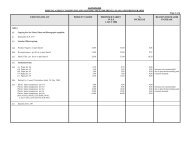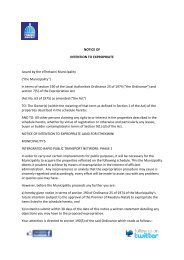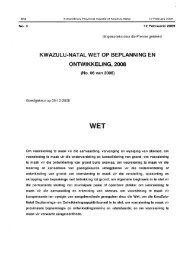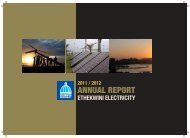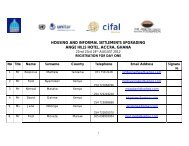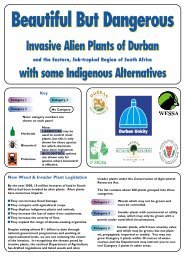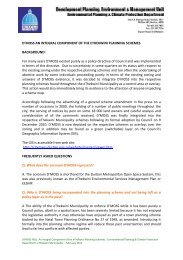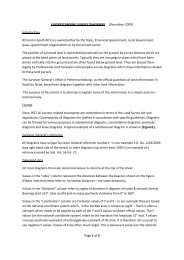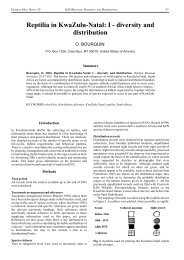Mullin, S. K., Taylor, P. J. & Pillay, N. 2004. Skull size and ... - Durban
Mullin, S. K., Taylor, P. J. & Pillay, N. 2004. Skull size and ... - Durban
Mullin, S. K., Taylor, P. J. & Pillay, N. 2004. Skull size and ... - Durban
You also want an ePaper? Increase the reach of your titles
YUMPU automatically turns print PDFs into web optimized ePapers that Google loves.
MULLIN_08 13/08/04 12:45 Page 14<br />
<strong>Mullin</strong> S. K. et al.<br />
P R O O F<br />
from Zimbabwe <strong>and</strong> the northern part of the Limpopo<br />
Province, South Africa formed subcluster 1<br />
while subcluster 2 comprised the remaining Limpopo<br />
Province OTUs (a) <strong>and</strong> material from the<br />
KwaZulu-Natal Province (b). Western Cape, South<br />
Africa D. i. capensis was found in subcluster 3.<br />
Fig. 5B showed Angolan D. incomtus (Cluster C)<br />
<strong>and</strong> D. nudipes (Cluster A) to be distinct <strong>and</strong><br />
separate from South African <strong>and</strong> Zimbabwean<br />
D. incomtus (Cluster B). The Okavango Delta<br />
OTUs did not group with any of the Angolan<br />
material (either D. incomtus or D. nudipes) <strong>and</strong><br />
instead was found within Cluster B1, with the<br />
exception of Kasane, which grouped with Zimbabwe<br />
individuals (Cluster B2). Dasymys i. capensis was<br />
14<br />
A B<br />
C D<br />
FIG. 5. – Phenograms of smaller data subsets. (a) Traditional measurements of specimens from Malawi, Mozambique, South Africa,<br />
Zambia <strong>and</strong> Zimbabwe (cophenetic correlation coefficient, 0.727). (b) Traditional measurements of specimens from Angola,<br />
Botswana, Namibia, South Africa <strong>and</strong> Zimbabwe (0.839). (c) Dorsal weight matrix of specimens from Angola, Democratic Republic of<br />
Congo <strong>and</strong> Nigeria (0.727). (d) Traditional measurements of specimens from Burkina Faso, Togo, Kenya, Ug<strong>and</strong>a, Tanzania, Malawi<br />
<strong>and</strong> Mozambique (0.819). , West African D. rufulus; 〈, D. foxi; ô, Cameroon, Central African Republic, Congo, Democratic Republic<br />
of Congo; σ, East Africa; ∠, D. montanus; , Malawi, Mozambique <strong>and</strong> Tanzania; τ, D. incomtus from Angola; υ, D. nudipes; ρ,<br />
Okavango Delta; ≤, Zambia; , Zimbabwe; θ, Limpopo <strong>and</strong> Mpumalanga Provinces, South Africa; ϖ, KwaZulu-Natal Province, South<br />
Africa; ÷, D. i. capensis. OTUs are defined in Table 1.<br />
also separate again (Cluster B2b). Zimbabwe <strong>and</strong><br />
South Africa OTUs (Cluster B2) were not completely<br />
separate as was seen in Fig. 5.<br />
Fig. 5C shows Cluster A (containing Angolan<br />
D. incomtus <strong>and</strong> material from Cameroon, the<br />
DRC, Central African Republic <strong>and</strong> Nigeria) as<br />
separate from both D. nudipes (B) <strong>and</strong> D. i. longipilosus<br />
(C). A strong geographic pattern was lacking<br />
within Cluster A, indicating the that OTUs were<br />
similar to each other, including D. foxi <strong>and</strong> the<br />
two Angolan D. incomtus OTUs, again questioning<br />
the validity of D. foxi as a separate species.<br />
Fig. 5D showed material in Cluster A, representing<br />
Burkina Faso, Togo, Tanzania, Malawi (OTU 80-<br />
Kasungu) <strong>and</strong> Mozambique (OTUs 83-Furancungo<br />
MAMMALIA • 2004 • 68 (2)


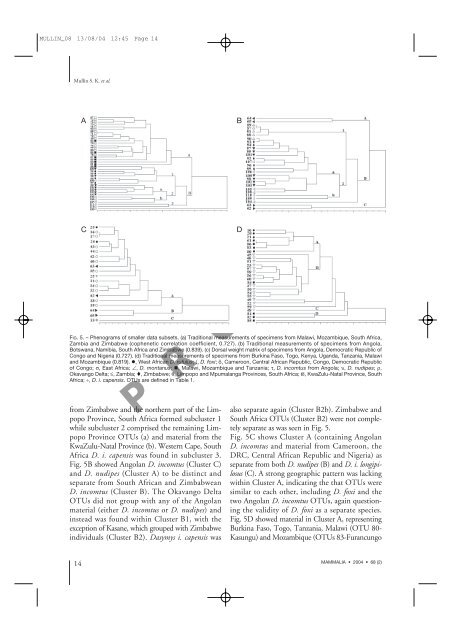
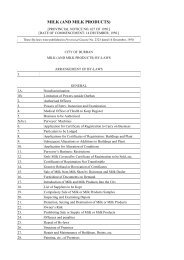
![INK Environmental Sustainability Booklet [19 MB] - Durban](https://img.yumpu.com/22025104/1/190x136/ink-environmental-sustainability-booklet-19-mb-durban.jpg?quality=85)

